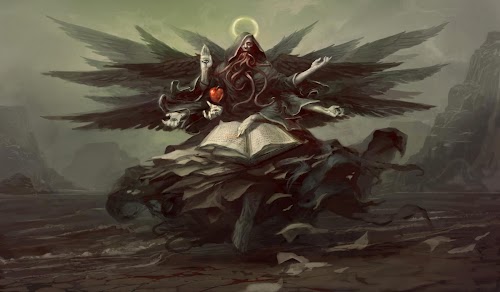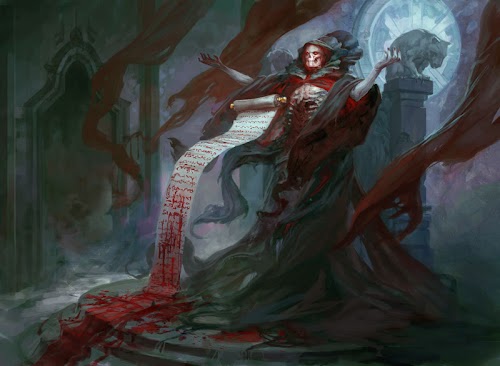
Peter Mohrbacher is a concept artist and illustrator best known for his work on Magic: The Gathering. He's been making card illustrations since 2010 and helped design the worlds for Return to Ravnica and Theros.
He's currently using some of his art to create prints and playmats using Kickstarter. Check out his project at https://kck.st/17U63xu. It ends 13 Dec 2013.
I took this opportunity to ask him about his art and inspiration.
Qn1: Can you give us an introduction on how you got started in art, your training and inspiration?
I had made simple drawings of video game characters throughout my childhood, but I don’t think anyone thought of me as artistic. But one morning, when I was 16, I woke up with a powerful urge to make artwork. It hit me like a ton of bricks and it’s never worn off.

During high school, I survived by projecting my fantasies onto paper. I would steal reams to printer paper from my school to fuel the number of drawings I was making. I was really into anime at the time, so I drew anime characters as well as designing and redesigning my own characters over and over again.
When it came to college, I got sucked into one of those horrible “for profit” schools because it was one of the only programs that offered a game art program. I really wanted to work in the game industry and this seemed like the best way to get in. I should have done more research. The program and facilities were horrible, but I used that time to get involved in online communities like CGTalk and Deviantart. By the time I graduated, I had taught myself how to paint digitally. It was during that time that I discovered my voice as an artist and I’ve been building on many of those themes and images ever since.
Qn2: You've produced many illustrations for Magic The Gathering cards. Can you talk about one of your favourite pieces and also one from another MTG artist?
Erebos, God of the Dead is probably the piece I am most proud of. I worked on the concept team for Theros and I designed Erebos early on in the process. He was the first god design to be approved and was used to help pitch the set internally at Wizards.

Erebos
When I was commissioned to illustrate Erebos, I got super excited! I stressed and fussed over it much more than normal because I knew that he was going to be a signature figure for me as well as Theros. When I saw him on the packaging art, I was ecstatic.

Surgical Extraction by Steve Belledin

Terror by Adam Rex
I love being a part of the Magic art community. There are so many pieces of art that make me want to stop and stare but every once in a while I will see a piece that really grabs me. Steve Belledin’s “surgical extraction” comes to mind. Steve is an artist’s artist. And I always love to see his originals at shows. I’m a fan of the high concept pieces most. Adam Rex’s “Terror” is another that I just freaked out when I saw it. Maybe I just like magic cards with skeletons on them!
Qn3: What type of images stir you the most? Can you give an example, maybe the first one that comes to mind?
I love images that have mystery in them. When there is something in the painting that is present but you cannot see, I get excited. It starts my imagination running! That feeling draws me into a painting to the point where I start to imagine the sounds and smells of the place. The work of Zdzislaw Beksinski is some of my favorite. His work contains this subtle human element locked behind the mysterious jumble of textures and symbols. His work can become intensely scary because of his amazing ability to balance relating gestures against strange and unknowable images. That juxtaposition is wildly unsettling, and it makes me want to engage the art even more.
Qn4: You've created a mentorship program for other artists recently. What's the most helpful critique you've received, either from your mentor or not? How did it help you?
I’ve been taking a mentorship with Rebbecca Leveille Guay through her online SmART School program. It was through this that I learned that a piece of advice I’d been giving people for years was all wrong. I always told people, that you need to forget about your imaginary audience and just focus on the piece that you want to make. But I was all wrong.
What I was really trying to express was that an artist needs to be present in their own work, which is important. But more importantly, they need to think about how their choices will affect their audience. I didn’t realize this, but I had been doing it all along without thinking about it. Every choice about a piece of art, from the colors, to the texture of the mark making sends a message to the viewer. It’s so important to be both a creator and observer while painting because you must be aware of how your decisions will be seen by someone interacting with your work.
Being more self conscience about my artistic choices has been helping me push my art into new territory for the first time in a years. I’m currently in the process of making many new additions to my portfolio to reflect this point of view. In short, it means that I’m making paintings where the characters have faces. Finally.

Qn5: What do you know now that you wished you knew earlier in your career?
I still love painting digitally and I’m never going to stop but there is a deep satisfaction to painting with physical materials. I wish I had taken opportunities to do it sooner.
It’s only in the past few years that I’ve ever picked up a brush and it has opened my eyes to things I would have never learned otherwise. I’m not sure it’s possible to truly learn about color until you’ve spent time mixing paint on a palette. There’s never been a more profound experience in my art education.


To get Peter Mohrbacher's art, visit his Kickstarter campaign at https://kck.st/17U63xu. It ends 13 Dec 2013.
And also check out more of his art and about the mentorship program at https://www.vandalhigh.com

